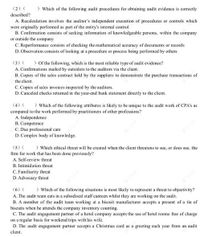
FINANCIAL ACCOUNTING
10th Edition
ISBN: 9781259964947
Author: Libby
Publisher: MCG
expand_more
expand_more
format_list_bulleted
Question

Transcribed Image Text:(2) (
) Which of the following audit procedures for obtaining audit evidence is correctly
described?
A. Recalculation involves the auditor's independent execution of procedures or controls which
were originally performed as part of the entity's internal control
B. Confirmation consists of seeking information of knowledgeable persons, within the company
or outside the company
C. Reperformance consists of checking the mathematical accuracy of documents or records
D. Observation consists of looking at a procedure or process being performed by others
) Of the following, which is the most reliable type of audit evidence?
(3) (
A. Confirmations mailed by outsiders to the auditors via the client.
B. Copies of the sales contract held by the suppliers to demonstrate the purchase transactions of
the client.
C. Copies of sales invoices inspected by the auditors.
D. Canceled checks returned in the year-end bank statement directly to the client.
(4) (
) Which of the following attributes is likely to be unique to the audit work of CPA's as
compared to the work performed by practitioners of other professions?
A. Independence
B. Competence
C. Due professional care
D. Complex body of knowledge.
(5) (
) Which ethical threat will be created when the client threatens to sue, or does sue, the
firm for work that has been done previously?
A. Self-review threat
B. Intimidation threat
C. Familiarity threat
D. Advocacy threat
) Which of the following situations is most likely to represent a threat to objectivity?
(6) (
A. The audit team eats in a subsidised staff canteen whilst they are working on the audit.
B. A member of the audit team working at a biscuit manufacturer accepts a present of a tin of
biscuits when he attends the company inventory counting.
C. The audit engagement partner of a hotel company accepts the use of hotel rooms free of charge
on a regular basis for weekend trips with his wife.
D. The audit engagement partner accepts a Christmas card as a greeting each year from an audit
client.
Expert Solution
This question has been solved!
Explore an expertly crafted, step-by-step solution for a thorough understanding of key concepts.
This is a popular solution
Trending nowThis is a popular solution!
Step by stepSolved in 2 steps

Knowledge Booster
Learn more about
Need a deep-dive on the concept behind this application? Look no further. Learn more about this topic, accounting and related others by exploring similar questions and additional content below.Similar questions
- 1) Name and describe the main tasks, duties or powers of the PCAOB. 2) What is audit risk? 3) What is materiality and how is it used or applied by the auditor.arrow_forward1. What is appropriate audit evidence? How does an auditor determine whether the appropriate audit evidence is sufficient to support the opinion expressed in the auditor's report? 2. Explain the types of audit proceduresarrow_forwarda) Auditors (Internal & External) are required to deal with fraud and error which represents risks to an entity. Their responsibilities however differ in relation to fraud and risks Required: (i) Explain what role the internal audit function plays in relation to risks of fraud and error in an entity. (ii) Whataretheresponsibilitiesofanexternalauditorinrelationtotheriskoffraud and error during the audit of financial statements?arrow_forward
- **Objective Question:** Which type of audit primarily focuses on ensuring that an organization complies with relevant laws, regulations, and internal policies? A) External audit B) Tax audit C) Compliance audit D) Forensic auditarrow_forwardSTATEMENT 1: Audit working papers are the documents accumulated by the auditor showing the procedures performed, audit testing applied, information obtained, and conclusions reached. STATEMENT 2: Audit working papers aid the auditor in the conduct and supervision of the audit engagement. A. Only Statement 1 is incorrect B. Only Statement 1 is correct C. Both statements are incorrect D. Both statements are correctarrow_forward
arrow_back_ios
arrow_forward_ios
Recommended textbooks for you

 AccountingAccountingISBN:9781337272094Author:WARREN, Carl S., Reeve, James M., Duchac, Jonathan E.Publisher:Cengage Learning,
AccountingAccountingISBN:9781337272094Author:WARREN, Carl S., Reeve, James M., Duchac, Jonathan E.Publisher:Cengage Learning, Accounting Information SystemsAccountingISBN:9781337619202Author:Hall, James A.Publisher:Cengage Learning,
Accounting Information SystemsAccountingISBN:9781337619202Author:Hall, James A.Publisher:Cengage Learning, Horngren's Cost Accounting: A Managerial Emphasis...AccountingISBN:9780134475585Author:Srikant M. Datar, Madhav V. RajanPublisher:PEARSON
Horngren's Cost Accounting: A Managerial Emphasis...AccountingISBN:9780134475585Author:Srikant M. Datar, Madhav V. RajanPublisher:PEARSON Intermediate AccountingAccountingISBN:9781259722660Author:J. David Spiceland, Mark W. Nelson, Wayne M ThomasPublisher:McGraw-Hill Education
Intermediate AccountingAccountingISBN:9781259722660Author:J. David Spiceland, Mark W. Nelson, Wayne M ThomasPublisher:McGraw-Hill Education Financial and Managerial AccountingAccountingISBN:9781259726705Author:John J Wild, Ken W. Shaw, Barbara Chiappetta Fundamental Accounting PrinciplesPublisher:McGraw-Hill Education
Financial and Managerial AccountingAccountingISBN:9781259726705Author:John J Wild, Ken W. Shaw, Barbara Chiappetta Fundamental Accounting PrinciplesPublisher:McGraw-Hill Education


Accounting
Accounting
ISBN:9781337272094
Author:WARREN, Carl S., Reeve, James M., Duchac, Jonathan E.
Publisher:Cengage Learning,

Accounting Information Systems
Accounting
ISBN:9781337619202
Author:Hall, James A.
Publisher:Cengage Learning,

Horngren's Cost Accounting: A Managerial Emphasis...
Accounting
ISBN:9780134475585
Author:Srikant M. Datar, Madhav V. Rajan
Publisher:PEARSON

Intermediate Accounting
Accounting
ISBN:9781259722660
Author:J. David Spiceland, Mark W. Nelson, Wayne M Thomas
Publisher:McGraw-Hill Education

Financial and Managerial Accounting
Accounting
ISBN:9781259726705
Author:John J Wild, Ken W. Shaw, Barbara Chiappetta Fundamental Accounting Principles
Publisher:McGraw-Hill Education